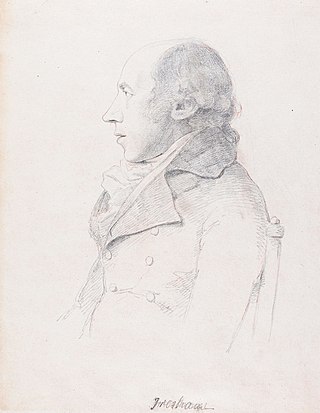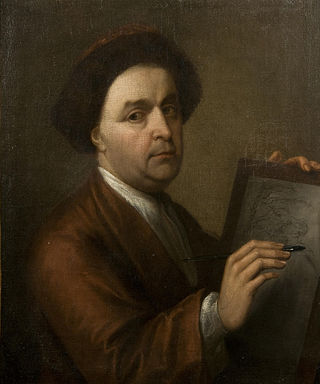
Founder of the Academy
Painter: Pompeo Batoni, around 1755 (1753–1756), oil on canvas, 97.8 × 73.7 cm

Painter: Marco Benefial, 1761
The Academy of English Professors of the Liberal Arts was a British art school in Rome. [1]


The Academy of English Professors of the Liberal Arts was a British art school in Rome. [1]
Some English artists and art lovers founded the English Art Academy in Rome for British and Irish artists on May 11, 1752, under the leadership of the art-loving Irish nobleman James Caulfeild (1728–1799) [2] [3] [4] – modeled after the already existing French Académie de France à Rome. [5] The new art school emerged from the earlier Academy of History Painters founded in 1748 by 16 English painters in Rome. [6] [7] At that time, the Italian capital had developed into a center of international art education.
The sole director of this art academy as well as its predecessor was the English historical and portrait painter John Parker, who had been in Rome for study purposes since 1745. Members of the academy included the architect William Chambers, the painters Gavin Hamilton, Thomas Patch, and Richard Wilson as well as the artist, collector, antiquities dealer, and banker Thomas Jenkins. The academy also functioned as a copying workshop for ancient Roman paintings for the English art market, [8] with Parker working as an art agent for his sponsor Charlemont, who probably refinanced his expenses in Rome through the sale of the paintings. [9]
However, the academy was closed down on Charlemont's orders after only six years in April 1758 due to disagreements among the artists working there. [10] Causes also included the dispute that began in 1756 between Giovanni Battista Piranesi, Parker, and Charlemont, [11] as well as earlier "misconduct" by the homosexual painter Thomas Patch, which led to his expulsion from Rome in 1755. Academy director John Parker also left Rome and was already at the Accademia di San Luca in 1756.

Giovanni BattistaPiranesi was an Italian classical archaeologist, architect, and artist, famous for his etchings of Rome and of fictitious and atmospheric "prisons". He was the father of Francesco Piranesi, Laura Piranesi and Pietro Piranesi.

Giovanni Antonio Canal, commonly known as Canaletto, was an Italian painter from the Republic of Venice, considered an important member of the 18th-century Venetian school.

Pompeo Girolamo Batoni was an Italian painter who displayed a solid technical knowledge in his portrait work and in his numerous allegorical and mythological pictures. The high number of foreign visitors travelling throughout Italy and reaching Rome during their "Grand Tour" led the artist to specialize in portraits.

Allan Ramsay was a Scottish portrait-painter.
Events from the year 1839 in art.

Benjamin West was a British-American artist who painted famous historical scenes such as The Death of Nelson, The Death of General Wolfe, the Treaty of Paris, and Benjamin Franklin Drawing Electricity from the Sky.

James Caulfeild, 1st Earl of Charlemont KP PC (Ire), was an Irish statesman.
Events in the year 1810 in Art.

George Barret Sr. was an Irish landscape artist known for his oil paintings and watercolours. He left Ireland in 1762 to establish himself as an artist in London and quickly gained recognition to become a leading artist of the period. He exhibited at the Society of Artists of Great Britain and was able to gain patronage from many leading art collectors. Barrett with other leading members left the Society in 1768 to found the Royal Academy, where he continued to exhibit until 1782.

Gavin Hamilton was a Scottish neoclassical history painter, who is more widely remembered for his searches for antiquities in the neighbourhood of Rome. These roles in combination made him an arbiter of neoclassical taste.
Events from the year 1756 in art.

Thomas Jenkins was a British artist who went to Rome accompanying the British landscape-painter Richard Wilson about 1750 and remained behind, establishing himself in the city by serving as cicerone and sometimes banker to the visiting British, becoming a dealer in Roman sculpture and antiquities to a largely British clientele and an agent for gentlemen who wished a portrait or portrait-bust as a memento of the Grand Tour.

Henry Tresham was an Irish-born British historical painter active in London in the late 18th century. He spent some time in Rome early in his career, and was professor of painting at the Royal Academy of Arts in London from 1807 to 1809.

The Warwick Vase is an ancient Roman marble vase with Bacchic ornament that was discovered at Hadrian's Villa, Tivoli about 1771 by Gavin Hamilton, a Scottish painter-antiquarian and art dealer in Rome, and is now in the Burrell Collection in Glasgow in Scotland.

George Henry Harlow was an English painter known mostly for his portraits.

Margaret Sarah Carpenter was an English painter. Noted in her time, she mostly painted portraits in the manner of Sir Thomas Lawrence. She was a close friend of Richard Parkes Bonington.

Thomas Patch was an English painter, printmaker in etching, physiognomist and art historian. He made a living from painting views of Florence and Tivoli and appears to have sold a number of painted caricature groups to members of the Anglo-Florentine community and to young British men on the Grand Tour. The largest collection of his paintings and prints is in the Lewis Walpole Library in Farmington, Connecticut.

Hamlet Winstanley (1698–1756) was an English painter, engraver and art agent. As a painter, he was mainly active as a portraitist and copyist.

Scottish art in the eighteenth century is the body of visual art made in Scotland, by Scots, or about Scottish subjects, in the eighteenth century. This period saw development of professionalisation, with art academies were established in Edinburgh and Glasgow. Art was increasingly influenced by Neoclassicism, the Enlightenment and towards the end of the century by Romanticism, with Italy becoming a major centre of Scottish art.

John Parker was an English history and portrait painter, who spent much of his career in Italy.